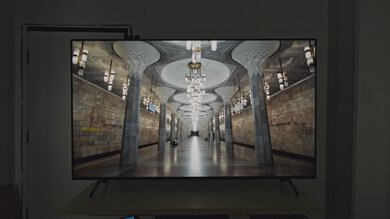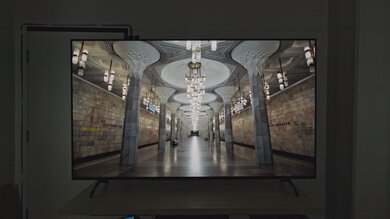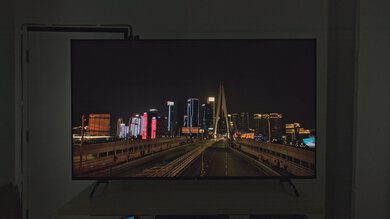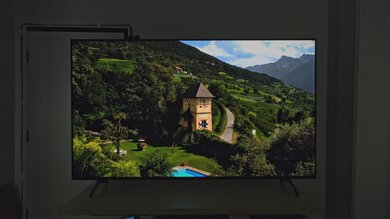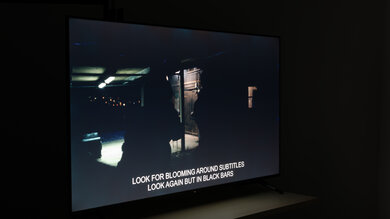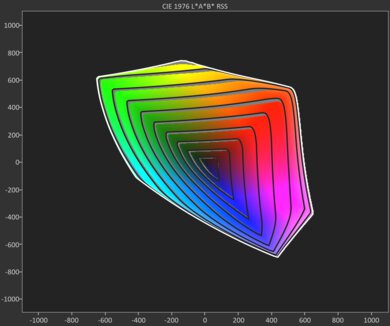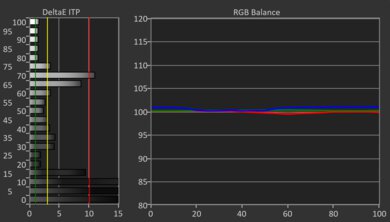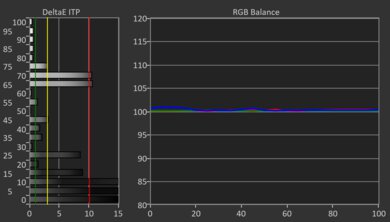The Sony BRAVIA 3 is an entry-level model in Sony's 2024 TV lineup. It's a pretty basic 60Hz TV and doesn't have features like HDMI 2.1 bandwidth, VRR, or local dimming, but it still has some features like black frame insertion, Auto Low Latency Mode, and Dolby Vision. You also get access to the Sony Pictures Core streaming service, which promises high-quality streams that rival the picture quality you get from 4k Blu-rays. The TV is powered by Sony's 4K HDR Processor X1™ and runs the popular Google TV smart interface. It has a built-in 20W 2.0 channel speaker system and supports Dolby Atmos. We bought and tested the 75-inch model, but it's available in six sizes total: 43, 50, 55, 65, 75, and 85-inches.
Our Verdict
The Sony BRAVIA 3 is sub-par for mixed usage. It's not a very good option to pair with your modern gaming console or PC since it lacks modern gaming features; you're limited to 4k @ 60Hz without VRR, with slow pixel transitions. The TV's terrible black levels mean blacks look gray all the time, so it doesn't look good when used in a home theater setup. While it has okay SDR brightness, enough to overcome glare in a room with some ambient lighting, it has poor direct reflection handling, so try to avoid placing lights directly opposite the screen. Fortunately, its good image processing makes it suitable for watching sports, as it cleans up SD or low-quality feeds well, and its wide viewing angle makes it a great choice for a wide seating arrangement.
-
Very good image processing for low-resolution and low-quality content.
-
Wide viewing angle means it's suitable for use in a group setting.
-
Bright enough in SDR for use in a well-lit room.
-
Extremely accurate in SDR.
-
Terrible black levels means blacks look gray at all times.
-
Limited to 60Hz refresh rate and no modern gaming features.
-
Lacks the HDR brightness needed for impactful highlights.
-
Poor direct reflection handling leads to distracting glare in bright rooms.
-
Slow pixel transitions lead to blurry motion.
The Sony BRAVIA 3 is a disappointing option for a home theater setup. It doesn't have the black levels necessary to provide an immersive HDR experience, as blacks are always raised, and this is especially noticeable in a dark home theater room. It's also dim in HDR, with only passable HDR color volume, so HDR highlights don't pop. Still, its processing is quite good, as it cleans up macro-blocking from low-bitrate content well and does a very good job when upscaling low-resolution content, like from DVDs. There's also little banding in HDR gradients. Its PQ EOTF tracking is decent; blacks and shadows are noticeably raised thanks to the TV's terrible black levels, but aside from that, it follows the curve closely. Additionally, there's not very much stutter, so motion in movies and TV shows is mostly smooth. However, it doesn't remove judder from 60Hz sources.
-
Very good image processing for low-resolution and low-quality content.
-
Good stutter performance.
-
Terrible black levels means blacks look gray at all times.
-
Lacks the HDR brightness needed for impactful highlights.
-
Doesn't remove 24p judder from 60Hz sources.
-
No DTS audio support.
The Sony BRAVIA 3 delivers an alright bright-room viewing experience. It's bright enough in SDR to overcome some glare in a well-lit room, but its direct reflection handling is poor, so direct light sources are distracting. At least its color volume is decent in SDR, with fantastic color accuracy, so the TV is colorful enough in SDR to satisfy most people. The TV's darker colors do lose some color saturation in well-lit rooms, but as the TV isn't extremely vibrant to begin with, you won't notice it. Its black levels, however, barely go down in well-lit contexts, but, again, since they're poor to begin with, they still look raised and washed out in most content.
-
Bright enough in SDR for use in a well-lit room.
-
Extremely accurate in SDR.
-
Poor direct reflection handling leads to distracting glare in bright rooms.
The Sony BRAVIA 3 is decent for watching sports, especially due to its wide viewing angle, so it's a good option for watching the game with a group of friends since the image doesn't drastically degrade when viewed from the sides of the screen. It also has good image processing, so it upscales low-resolution content well, such as SD broadcasts on cable. It cleans up streaming artifacts very well too, so those of you watching sports through a streaming app also get a clean-looking image. Its SDR color volume is decent, and it's also extremely accurate, so your favorite teams' jerseys look colorful enough, as well as look exactly like you remember them. Just try to avoid placing the TV in bright rooms, as its reflection handling isn't good enough to deal with lamps or windows placed directly opposite the screen.
-
Very good image processing for low-resolution and low-quality content.
-
Wide viewing angle means it's suitable for use in a group setting.
-
Bright enough in SDR for use in a well-lit room.
-
Extremely accurate in SDR.
-
Poor direct reflection handling leads to distracting glare in bright rooms.
-
Slow pixel transitions lead to blurry motion.
The Sony BRAVIA 3 is inadequate for playing video games. Unfortunately, it doesn't have modern gaming features like HDMI 2.1 bandwidth, 4k @ 120Hz, or VRR, so it's not a good option if you're looking to get the most out of your PS5, Xbox Series X|S, or gaming PC. The TV's pixel transitions are slow across the board, so there's noticeable blur behind fast motion. Fortunately, the TV does have low input lag at 60Hz, so you'll still get a somewhat responsive gaming experience. When it comes to image quality, the TV's not bright enough in HDR to offer an immersive HDR gaming experience, as it has terrible black levels.
-
Low input lag at 60Hz.
-
Terrible black levels means blacks look gray at all times.
-
Limited to 60Hz refresh rate and no modern gaming features.
-
Lacks the HDR brightness needed for impactful highlights.
-
Slow pixel transitions lead to blurry motion.
The Sony BRAVIA 3's brightness performance is mediocre. Its SDR brightness is okay, but the TV is dim in HDR, so highlights don't pop, leading to a lackluster HDR viewing experience.
-
Bright enough in SDR for use in a well-lit room.
-
Lacks the HDR brightness needed for impactful highlights.
The Sony BRAVIA 3 has terrible black levels. The TV doesn't have local dimming, so blacks look blueish and cloudy at all times, even with its passable black uniformity.
-
Terrible black levels means blacks look gray at all times.
The Sony BRAVIA 3 has decent color performance overall. Its color volume is passable in HDR but decent in SDR; it's colorful enough for most people, but it's not exceptionally vibrant. Its color accuracy in HDR is okay, so purists won't be satisfied, but everyone else will. Thankfully, its color accuracy in SDR is truly fantastic, so it's at its best when paired with SDR content from streaming services or physical media.
-
Extremely accurate in SDR.
Note: We're in the process of improving our tests related to image processing, but this score will give you a general idea of how a model performs overall with its image processing capabilities.
The Sony BRAVIA 3's image processing is good overall. It cleans up macro-blocking from low-bitrate content quite well and does a very good job when upscaling low-resolution content, like from DVDs. There's also little banding in HDR gradients, although there is some if you look closely. Its PQ EOTF tracking is decent; blacks and shadows are noticeably raised, leading to gray-looking blacks, but aside from that, it follows the curve closely.
-
Very good image processing for low-resolution and low-quality content.
The Sony BRAVIA 3's responsiveness in Game Mode is inadequate. It doesn't support VRR, so you do see screen-tearing. Although the TV's input lag at 60Hz is low enough for a responsive feel, it doesn't support 120Hz and above, limiting the TV's usability for those who seek a truly responsive gaming experience. Plus, the TV's pixel transitions are slow across the board, resulting in visible motion blur.
-
Low input lag at 60Hz.
-
Limited to 60Hz refresh rate and no modern gaming features.
-
Slow pixel transitions lead to blurry motion.
We're in the process of fixing the way we evaluate a TV's overall motion handling. This section is currently broken, and the score isn't indicative of how well a TV handles motion overall.
- 5.7 Mixed Usage
- 5.5 Home Theater
- 6.5 Bright Room
- 7.0 Sports
- 5.1 Gaming
Performance Usages
- 6.0 Brightness
- 2.8 Black Level
- 7.0 Color
- 7.7 Processing (In Development)
- 5.2 Game Mode Responsiveness
- 7.5 Motion Handling (Broken)
Changelog
-
Updated Jun 12, 2025:
Mentioned the newly reviewed Sony BRAVIA 5 in the Contrast section.
- Updated May 08, 2025: Converted to Test Bench 2.0.1. We did this to fix an issue with our scoring in the Supported Resolutions section, since TVs with a refresh rate higher than 144Hz were being penalized for not supporting 144Hz.
-
Updated Mar 26, 2025:
We rechecked the TV's ATSC support and updated the results and text in the Input Specifications section after confirming the TV is limited to ATSC 1.0.
-
Updated Mar 26, 2025:
We wrote text for the new tests and rewrote text throughout the review after updating pre-existing tests and scores for Test Bench 2.0.
- Updated Mar 26, 2025: We converted the review to Test Bench 2.0. With this new methodology, we've added new tests to expand the scope of our testing, adjusted our scoring to better align with current market conditions, and added performance usages that group related tests together to give more insight into specific aspects of a TV's performance. You can find a full list of changes in the TV 2.0 changelog.
Check Price
Differences Between Sizes And Variants
We bought and tested the 75-inch Sony BRAVIA 3, and the results are also valid for the 43-inch and 55-inch models. There are reports that the 50-inch, 65-inch, and 85-inch models use a VA panel, so we expect those to have better contrast and a worse viewing angle. The type of panel used may vary between regions, so this information is only valid for the North American models.
Costco has variants of the 55, 65, 75, and 85-inch sizes with slightly different model codes. These variants perform the same but come with an extended warranty, an extended trial for the Sony Pictures Core streaming service, and a backlit remote.
| Size | US Model | Costco Variant | Panel Type |
|---|---|---|---|
| 43" | K-43S30 | - | IPS |
| 50" | K-50S30 | - | VA |
| 55" | K-55S30 | K55S30CB | IPS |
| 65" | K-65S30 | K65S30CB | VA |
| 75" | K-75S30 | K75S30CB | IPS |
| 85" | K-85S30 | K85S30CB | VA |
Our unit was manufactured in April 2024.
Popular TVs Comparisons
The Sony BRAVIA 3 is an unremarkable TV. It doesn't do anything that separates it from the crowd of other entry-level models. It doesn't have a local dimming feature, and its black levels are terrible, so blacks are gray most of the time, and HDR content isn't very impactful. Its SDR brightness is decent enough to overcome some glare in a room with the lights on. However, its handling of direct reflections, such as from lights placed in front of the screen, limits its usefulness in a bright room. It's also very limited with modern gaming features, so it's not a good option if you're looking for a TV to pair with your modern console or gaming PC. If you don't need modern gaming features but still want a TV that looks good overall, you're better off buying a TV like the cheaper Hisense U6/U6N, as that TV has a local dimming feature that provides significantly better contrast. If you do need modern gaming features, you can even get the fully-featured Hisense U7N or the TCL QM7/QM751G QLED for around the same cost as the BRAVIA 3.
For more options, check out our recommendations for the best TVs under $1,000, the best 65-inch TVs, and the best TVs for gaming.
The Sony X90L/X90CL is much better than the Sony BRAVIA 3. The X90L has a local dimming feature to improve its contrast, so blacks are much deeper and stay deep when highlights are also on screen. It's also the brighter TV overall, meaning it overcomes more glare in a bright room and provides a more impactful HDR experience. The X90L is also much better for gaming due to its HDMI 2.1 bandwidth, up to 4k @ 120Hz, VRR feature, and faster response time.
The Sony BRAVIA 3 is better than the Sony X77L/X77CL. The BRAVIA 3 is the brighter of the two, especially in SDR, and has a much wider color gamut, giving it a more impactful viewing experience. Finally, the newer BRAVIA 3 also has better image processing, so it outpaces the X77L on almost every metric.
The Samsung Q60D and the Sony BRAVIA 3 are very similar TVs that are better than each other in different ways. The Samsung has better contrast and black uniformity, so it displays deeper blacks in a dark room. On the other hand, the Sony is the more accurate TV in SDR and HDR, and it has better image processing. The Sony also has a wider viewing angle, so it's the better option for watching TV in a group setting.
The Sony BRAVIA 3 is a bit better than the Sony X80K/X80CK. The BRAVIA 3 is a bit brighter overall, so it fights more glare in a room with the lights on, and highlights stand out slightly more in HDR content. The BRAVIA 3 has better PQ EOTF tracking and pre-calibration accuracy, so it's more accurate in SDR and HDR. Finally, the BRAVIA 3 has significantly better low-quality content smoothing, so it does a better job at removing artifacts in low-bitrate content.
The Sony BRAVIA 3 is a bit better than the Samsung DU7200. The Sony is brighter in HDR and SDR and is also the most accurate TV of the two out of the box. Its image processing is far better than that of the Samsung model, which is typical of Sony's TV lineup. It also has a far wider viewing angle, making it a better choice for wide seating arrangements than the Samsung. Still, the Samsung TV has far better contrast, giving it the edge in pitch-black rooms.
The LG C4 OLED is much better than the Sony BRAVIA 3. The LG displays significantly deeper blacks, so it looks much better in a dark room. The LG also gets brighter in HDR and has a wider color gamut, so highlights stand out a lot more, and colors are more vibrant in HDR content. The LG also has modern gaming features like HDMI 2.1 bandwidth, VRR, and up to 4k @ 144Hz, so it's a better option for modern gaming consoles or PCs. Additionally, the LG's much faster response time delivers fast motion with almost no blur.
The Hisense U6N is mostly better than the Sony BRAVIA 3. The Hisense has a local dimming feature that drastically improves the TV's contrast, so it delivers much deeper blacks in a dark room. The Hisense also has a faster response time, so there's less blur behind quick motion in sports and video games. Although both TVs don't have HDMI 2.1 bandwidth or support for 4k @ 120Hz, the Hisense supports VRR, and you can game in up to 1440p @ 120Hz, so it's the better option for gamers. However, the Sony does have better image processing; it does a slightly better job at upscaling and a significantly better job at removing artifacts from low-quality content.
Video

We buy and test dozens of TVs yearly, taking an objective, data-driven approach to deliver results you can trust. Our testing process is complex, with hundreds of individual tests that take over a week to complete. Most of our tests are done with specially designed test patterns that mimic real content, but we also use the same sources you have at home to ensure our results match the real-world experience. We use two main tools for our testing: a Colorimetry Research CR-100 colorimeter and a CR-250 spectroradiometer.
Test Results
The TV has just sub-par HDR brightness. Some highlights stand out a bit in darker scenes, but the TV's HDR brightness isn't good enough to display brighter highlights with impact.
These measurements are after calibrating the HDR white point with the following settings:
- HDR Picture Mode: Professional
- Brightness: Max
- Contrast: Max
- Color Temperature: Expert 2
There's no noticeable difference in HDR brightness when the TV is set to Game Mode.
These measurements are after calibrating the HDR white point with the following settings:
- HDR Picture Mode: Game
- Brightness: Max
- Contrast: Max
- Color Temperature: Expert 2
The TV has adequate SDR brightness, and it overcomes some glare in a room with the lights on.
These measurements are after calibration with the following settings:
- HDR Picture Mode: Professional
- Brightness: Max
- Contrast: 90
- Gamma: 0
- Color Temperature: Expert 1
The Sony BRAVIA 3 has terrible contrast. Blacks are raised and look gray most of the time, and the TV lacks a local dimming feature to improve its contrast. You can get significantly better contrast by stepping up to the Sony BRAVIA 5.
This TV doesn't have a local dimming feature, so it can't adjust the backlight of individual areas to brighten up highlights without impacting the rest of the image. This means that there are no distracting flickers or brightness changes as bright highlights move across the screen.
The Sony BRAVIA 3 has decent SDR color volume. Its coverage of the wide BT.2020 color space is mediocre, and it really struggles with displaying most colors outside of some purples and blues. Its coverage of the narrower DCI-P3 color space is good, but here, it particularly struggles with fully displaying greens, yellows, and lighter reds.
| Volume ΔE³ | DCI-P3 Coverage | BT.2020 Coverage |
|---|---|---|
| L10 | 77.39% | 53.75% |
| L20 | 86.39% | 61.81% |
| L30 | 88.42% | 63.68% |
| L40 | 88.95% | 65.63% |
| L50 | 88.81% | 66.27% |
| L60 | 87.97% | 64.70% |
| L70 | 86.96% | 57.09% |
| L80 | 86.00% | 54.56% |
| L90 | 85.47% | 54.88% |
| L100 | 86.30% | 66.10% |
| Total | 87.28% | 60.72% |
The TV has passable HDR color volume, but it doesn't do a very good job of displaying dark saturated colors due to its terrible contrast. It also can't display most colors very brightly.
The Sony BRAVIA 3 Series has fantastic pre-calibration SDR accuracy. The TV's white balance is outstanding, with blues, reds, and greens just a bit underrepresented in shades of gray. The color temperature is exactly at 6500K, and it does an excellent job of displaying colors with accuracy, but there are still some minor inaccuracies with most colors. Gamma is close to our target of 2.2, but all scenes are displayed darker than intended.
The TV has remarkable SDR accuracy after calibration. There are no noticeable issues with white balance, and gamma is perfectly at our target of 2.2. There are still some minor inaccuracies with some colors, but these aren't noticeable to most people.
You can see our full calibration settings.
The TV has okay HDR accuracy before calibration. Blues, and to a lesser extent greens, are overrepresented in darker and brighter shades of gray, but not so much in mid-grays. This makes the TV's color temperature far colder than the 6500K target, giving everything a very noticeable blue tint. It has good color accuracy overall, but there are numerous inaccuracies in most colors, especially in warmer tones.
The TV has decent HDR accuracy after calibration. While the TV's white balance is improved, blues are still overrepresented in darker grays, and even a bit in mid-grays now, so the TV's color temperature is still extremely cold. Color accuracy is better now, but there are still some inaccuracies across its range of colors.
The Sony BRAVIA 3 has decent PQ EOTF tracking. Blacks and near-blacks are noticeably raised, but the TV follows the curve very closely until it approaches its peak brightness. The TV has the same gradual roll-off near its peak brightness for content mastered at all three nit levels to preserve some details in highlights.
The TV does an impressive job with upscaling low-resolution content like DVDs, standard definition cable channels, and lower-resolution streams. Details are well-defined and clear enough, but very fine details are a bit hard to make out.
Sharpness processing was calibrated with no over-sharpening for low-resolution content, with the following settings:
- Sharpness: 60
- Reality Creation: Auto
The TV has good HDR gradient handling. There's noticeable banding in dark grays and bright greens, but all other colors have minimal banding.
This TV has low input lag at 60Hz when set to Game Mode and Graphics Mode, but it doesn't support 120Hz and above at any resolution, limiting its usability when it comes to responsive high refresh rate gaming.
The Sony BRAVIA 3 supports almost all common resolutions up to 4k @ 60Hz. It displays chroma 4:4:4 properly with any signal as long as the TV is in Graphics Mode, which is important for reading clear text from a PC.
This TV doesn't support VRR to reduce screen tearing.
This TV doesn't support a 120Hz refresh rate.
The Sony BRAVIA 3 is a 60Hz TV, so it only supports up to 4k @ 60Hz on the PS5. It has Auto Low Latency Mode (ALLM), so it'll automatically switch to Game Mode when the TV detects a game console as its input device, which gives you the lowest possible input lag for games. The TV doesn't support 1440p.
The Sony BRAVIA 3 is a 60Hz TV, so it only supports up to 4k @ 60Hz on the Xbox Series X|S. It has Auto Low Latency Mode (ALLM), so it'll automatically switch to Game Mode when the TV detects a game console as its input device, which gives you the lowest possible input lag for games. It also supports Dolby Vision for gaming, but it doesn't support 1440p.
Due to the TV's slower response time, there's only some minor stutter when watching movies or TV shows, and it's only noticeable during slow panning shots.
The Sony BRAVIA 3 automatically removes judder from 24Hz sources like a Blu-ray player and the native apps. Unfortunately, it doesn't remove 24p judder from 60Hz sources like most cable TV boxes and older streaming devices that lack a Match Frame Rate feature.
The TV has an optional backlight strobing feature, commonly known as black frame insertion, to reduce persistence blur. It only flickers at 120Hz, which causes image duplications with 60 fps content.
The TV has an optional motion interpolation feature to improve the clarity of motion, but it doesn't work very well. Even slower-moving scenes have some noticeable artifacts. The TV really struggles in faster-moving scenes, and there are distracting artifacts and haloing, and at times, the TV stops interpolating altogether.
The Sony BRAVIA 3 does a poor job of handling direct reflections. It barely lessens the intensity of bright light sources, so the reflections on the screen are bright and distracting.
The Sony BRAVIA 3 TV does an excellent job retaining its black levels in a bright room. Blacks are barely raised as more light is added to your room, so you get very similar blacks regardless of your lighting. That said, the TV has terrible black levels to begin with, so you never see deep blacks on this model.
The amount of total reflected light is decent. It reduces the intensity of reflections, but they're still quite noticeable in a room with more than one or two lights on, especially during dark scenes. Fortunately, there's no artifacts like rainbow smearing or light banding.
The TV has mediocre color saturation when used in a well-lit room. There’s barely any difference with the vibrancy of colors whether you’re in a dark room or a bright one, although brighter colors look slightly more washed out.
The TV has a very good viewing angle. Colors wash out, and there's some brightness loss the further you move off-center. However, the image remains mostly consistent when viewed from the sides of the screen. This makes it a good option for a wide seating arrangement.
The Sony BRAVIA 3 has decent gray uniformity, although the corners are darker than the rest of the screen, and there's some dirty screen effect towards the center. On a very dark or near-black screen, its uniformity is very good, with only the edges being slightly lighter than the rest of the screen.
The TV has an RGB sub-pixel layout, so it doesn't have any issues rendering text when used as a PC monitor.
Note that there are reports that the 50-inch, 65-inch, and 85-inch models use a VA panel with a BGR subpixel layout, which can affect text clarity.
The TV uses a KSF phosphor coating to produce red light, with high peaks on reds and blues. This model does have good separation between colors, giving it solid color purity and a wide color gamut.
The TV is limited to HDMI 2.0 bandwidth on all four ports, but it does support Dolby Vision. Unfortunately, this model only has an ATSC 1.0 tuner, so 4k over-the-air isn't possible.
The TV has eARC support, which allows it to pass uncompressed high-quality audio from a connected source to your home theater system or soundbar. Unfortunately, it doesn't support any DTS formats commonly used on Blu-rays.
The TV is very reminiscent of the Sony A80K/A80CK OLED, with a basic design that looks good overall.
The TV comes with two metal feet. They're set wide apart and can't be adjusted, so they take up a lot of space, and you'll need a large cabinet for the larger sizes. The feet lift the TV about 3.86 inches above the table, so most soundbars fit underneath without blocking the screen.
Footprint of the 75-inch model: 52.28" x 16.14".
The back of the TV is made entirely of plastic and has the familiar checkerboard pattern similar to many other Sony TVs. The inputs are on the far left side of the TV when facing the front, but they're in a recessed cutout, so they're a bit hard to reach if you have the TV mounted flush to the wall. Clips on the feet can be used to help with cable management.
The remote has a matte finish with blue speckles. Outside of that, it's identical to the remotes included with most of Sony's 2023 models. It has buttons for popular streaming services, and you can use the built-in microphone to switch inputs, change apps, search within apps, and ask for the weather and time.
The TV has an alright frequency response. Like most TVs, there's almost no bass. Dialogue is clear at most listening levels, but the sound becomes quite unbalanced at the TV's maximum volume. Since the speakers don't get very loud, it's best suited for a quiet environment.
Comments
Sony BRAVIA 3: Main Discussion
Let us know why you want us to review the product here, or encourage others to vote for this product.
- 10-11-1
There was a FIRMWARE update in Feb or March That made the TV better Do you have the info on this somewhere It’s to do with how the TV Controls the IMAGES Much Better Almost as if it had A Local Dimming Feature to Make the Image Much Better over-all ??????????????????
- 43230
Unless if you’re playing modern video games refresh rate doesn’t matter. If somebody gave me a TCL or Hisense TV I would throw them in the dumpster. I’m an electronics technician and those TV’s are junk
Agree. From current personal experience my X90L kicks the shit out of my TCL QM7 . Even with android 10 the X90L functions better overall than that TCL with Android 12. There are also several other glitches I’ve noticed just in general pq. Yes the TCL is bright. But dimming zone transition sucks. It has crushed blacks or lifted blacks. No happy medium. The VVR never works properly.
Sony definitely makes a better tv. All these high ratings are a joke on these TCLs and Hisence tvs. Ive fallen for it for the last time.
- 32120
Please rtings, do a review for the 50-inch Sony Bravia 3, this 50-inch is a completely different TV than the 75-inch Bravia 3 you tested. I think you will have very big surprises from the 50-inch Bravia 3.
- 21010
I’m new in this forum but I have a question if you can help me: for the same price I have Sony Bravia 3 K65S32BP (https://www.mediaworld.it/it/product/_sony-65-bravia-3-s35b-432769.html?utm_term=&gad_campaignid=19672025408)
and SAMSUNG QE65QN85DBTXZT Mini LED TV NEO QLED, 65 “ (https://www.mediaworld.it/it/product/_samsung-qe65qn85dbtxzt-65-pollici-uhd-4k-364563.html)
which one is the better one?
Edited 1 month ago: grammar error Update: Mentioned the newly reviewed Sony BRAVIA 5 in the Contrast section.
- 21010
If you put the TV in HDR10 mode and adjust your settings from there , And save to all Inputs and outputs for you watching This should give you the best possible Picture This is important for people to know Just a thought if you could add something like this for every TV Review you do
Update: We wrote text for the new tests and rewrote text throughout the review after updating pre-existing tests and scores for Test Bench 2.0.


